SEDE VACANTE 1978
(August 6, 1978-August 26, 1978)
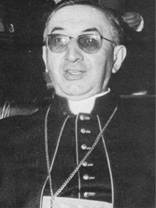
Jean Cardinal Villot
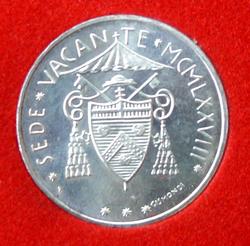 |
AG 500 lire • SEDE • VACAN TE • MCMLXXVIII • GISMONDI Arms of Jean Card. Villot, Camerlengo of the Holy Roman Church, crossed keys behind; surmounted by Cardinal's Hat, with fifteen tassels and, above all, the Ombrellone. |
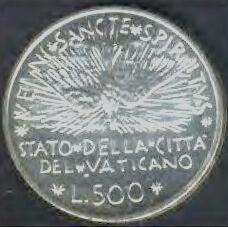 |
• VENI • SANCTE • SPIRITVS || STATO • DELLA • CITTA | DEL • VATICANO | • L. 500 • The Holy Spirit, surrounded by rays of light. Berman, p. 220 #3498. KM 140. |
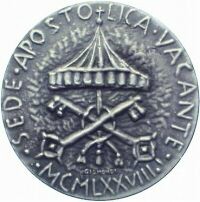 |
AG proof Obv.: SEDE • APOSTOLICA • VACANTE • MCMLXXVIII • Keys of St. Peter, crossed on the pole of the Ombrellone, joined by a cord. GISMONDI |
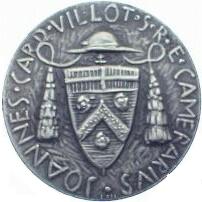 |
|
SEDE VACANTE
(September 28, 1978—October 16, 1978)
 |
AG 500 lire SEDE VACANTE | SEPTEMBER MCMLXXVIII Arms of Jean Card. Villot, Camerlengo of the Holy Roman Church, crossed keys behind; surmounted by Cardinal's Hat, with fifteen tassels and above all the Ombrellone. |
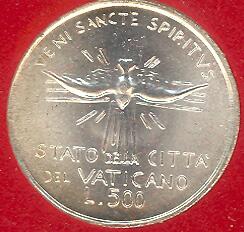 |
VENI SANCTE SPIRITVS || STATO | CITTA | DEL VATICANO | L. 500 The Holy Spirit, surrounded by rays of light in the form of a cross. Berman, p. 221 #3500. KM 141. |
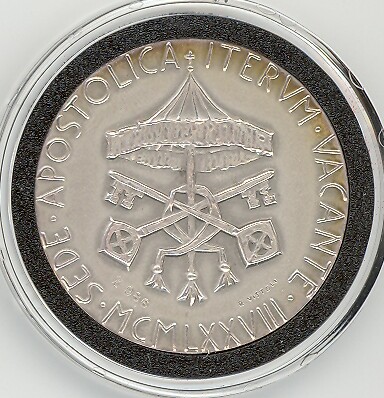 |
AG proof Obv.: SEDE • APOSTOLICA | ITERVM • VACANTE • MCMLXXVIII • Keys of St. Peter, crossed on the pole of the Ombrellone, joined by a cord. R•VISTOLI |
 |
|
Leaders
JEAN CARDINAL VILLOT (1905-1979) was born near Clermont-Ferrand in central France. He was ordained priest in Rome in 1930, during his studies at the Pontifical Angelicum Athenaeum. From 1934, he worked in the Archdiocese of Lyon in France, as a faculty member at the seminary and at the Catholic University; he also did pastoral work in the diocese until 1950. He was Secretary of the French Episcopal Conference from 1950 to 1954. He was appointed Auxiliary Bishop of Paris in 1954, and Coadjutor Archbishop of Lyon in 1959, succeeding to the Archdiocese in 1965. In 1965 he was created Cardinal Priest of SSma. Trinita al Monte. On May 2, 1969 he became Secretary of State of the Vatican City State, and was named Camerlengo of the Holy Roman Church on October 16, 1970, a post he held until his death on March 9, 1979. In 1971 he was appointed President of the Pontifical Council "Cor Unum" (resigned September 1978). He was promoted Cardinal Bishop of Frascati on December 12, 1974. He died in Rome on March 9, 1979.
The Dean of the Sacred College of Cardinals was Carlo Cardinal Confalonieri (1893-1986). He had been Cardinal Achille Ratti's conclavist in the Conclave of 1922, and when Ratti was elected Pope Pius XI, he served as his Secretary until 1939. In 1941 he was appointed Archbishop of Aquila. In 1950 he became Secretary of the Sacred Congregation for Seminaries and Universities and titular Archbishop of Nicopolis ad Nestum in Thrace. He was made Cardinal Priest of S. Agnese fuori le mura in December 1958 by John XXIII. He was promoted to Cardinal Bishop of Palestrina in 1972, and became Dean of the Sacred College on December 12, 1977. Because he had passed the age of 80, he was not allowed to participate in the conclaves on 1978, though he did preside at the Congregations of Cardinals leading up to the Conclave.
The Secretary of the Conclave was Msgr. Ernesto Civardi (1906-1989), of Fossarmato, near Pavia. He had earlier been vice-Rector of the Lombard Seminary in Rome (1932-1934). He was given a position in the Consistorial Congregation in 1934. He became "sostituto" in the Congregation of Bishops (1953-1967); counselor at the Congregation for the Propagation of the Faith (1965-1967); and then Secretary of the Congregation of Bishops (1967-1979)—who also serves as Secretary of the College of Cardinals. He was made a titular bishop (Sardica) in 1967, an appointment consonant with his Secretaryship. He was raised to the Cardinalate by John Paul II on June 30, 1979 (Cardinal Deacon of S. Teodoro).
The Sacristan of the Conclave was the papal sacristan, Msgr. Pieter van Lierde.
The Master of Ceremonies was Msgr. Virgilio Noè, born near Pavia in Lombardy in 1922. Formerly President of his own diocese's Liturgical Commission. Secretary, and then President, of the Center of Liturgical Action in Rome, and a member of the faculty at the Liturgical Institute of S. Anselmo. Undersecretary of the Congregation for Divine Worship (from 1969), under Cardinal Antonio Samorè. [Master of Ceremonies, January 9, 1970-March 6, 1982]. In 1982 he was named a titular bishop (Voncaria) and consecrated by John Paul II himself. It was widely believed that he was being eased out of his position as Master of Ceremonies because John Paul II greatly disliked his intrusive fussiness on every public occasion. His stubborn reluctance to modernize the papal liturgical ceremonies in the spirit of Vatican II also contributed to his replacement. He was named Secretary of the Congregation of Sacraments and Divine Worship (the new title for the old congregation), under Cardinal Giuseppe Casoria. He was created Cardinal Deacon of S. John Bosco at the age of 69 on June 28, 1991, and immediately named Archpriest of S. Peter's (He had been coadjutor of Cardinal Sabbatini, from which post he resigned in 2002 upon reaching the age of eighty.
The office of Marshal of the Holy Roman Church, once the hereditary possession of the Chigi Albano della Rovere, had been abolished by Paul VI in 1968. Its functions were carried out by a triumviral commission: the Prefect of the Pontifical Household (Msgr. Jacques Martin), the Special Delegate of the Pontifical Commission for Vatican City (Marchese Giulio Sacchetti), and the Prefect of the Swiss Guard (Col. Franz Pfyffer von Altishofen).
August Conclave
On August 25, 1978, at 11:00 a.m., he Mass of the Holy Spirit was sung in St. Peter's Basilica by Cardinal Carlo Confalonieri, the Dean of the Sacred College of Cardinals. The homily was pronounced by Cardinal Jean Villot, who had vacated the office of Secretary of State, but who was also Camerlengo. That afternoon, between 4:00 and 5:00 pm the Cardinals entered the Sistine Chapel in procession and took their seats. Cardinal Villot was strongly taken to task at the time for prolonging the beginning of the August Conclave to the latest possible moment allowed by the Constitution of Paul VI.
The principal contenders for the papacy in the preliminary pratticà were Giuseppe Siri of Genoa (the candidate of curial arch-conservatives); Albino Luciani of Venice (who was being promoted by Giovanni Benelli, Carlo Confalonieri, and Alosio Lorscheider); Sergio Pignedoli; Sebastiano Baggio (a curial cardinal).
Albino Cardinal Luciani, Patriarch of Venice, was elected on the first day of the Conclave, on the third ballot (August 26, 1978).
September Conclave
The September Conclave was overshadowed by charges that began the day of John Paul I's death, that the pope had been assassinated. Villot's official story of the death of the pope and the discovery of the body by his staff was immediately discredited, and the proceedings went forward in an atmosphere of suspicion and criticism of the Roman Curia's management of the Interregnum.
The leading candidates were the extremely conservative Giuseppe Card. Siri (Genoa) and the progressive Giovanni Card. Benelli (Florence). Benelli had been the principal manager of the campaign of Cardinal Luciani in the August Conclave, and had decided that he had to offer himself as the candidate of those committed to the reform of the Vatican Curia and the further implementation of the decisions of the Second Vatican Council. When Cardinal Siri's candidacy failed, the most conservative faction turned to Cardinal Pericle Felici. When the Italian candidates were unable to muster sufficient support, the Cardinals, impelled by Cardinals Koenig (Vienna) Enrique y Tarancon (Madrid) and Krol (Philadelphia), turned to Karol Cardinal Wojtyla of Cracow in Poland, who was elected pope (John Paul II) on the eighth ballot on October 16, 1978. It was apparently believed by these Electors that Wojtyla was committed to continue and advance the reforms initiated by the Second Vatican Council. In this matter, the Holy Spirit did not enlighten them.
F. A. Burkle-Young, Passing the Keys (Lanham MD: Madison Books 1999) 227-260; 261-293. Gordon Thomas and Max Morgan-Witts, Pontiff (New York: Doubleday 1983)